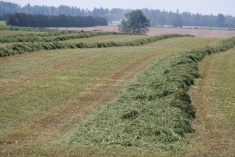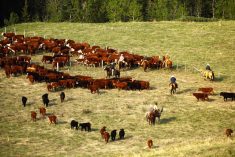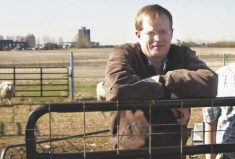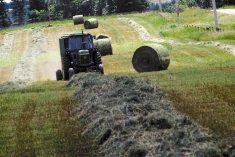Hay goes on a diet in winter, but how much weight it loses depends on how it was stored.
“Over the course of a winter, bales weather and lose both weight and quality,” said provincial beef and forage specialist Barry Yaremcio. “This poses the key question of what kind of value losses occur when storing the bales outside unprotected from the elements.”
A study on overwinter outdoor bale storage done in the Westlock area found a 5.7 per cent reduction in bale weight over the first winter. That means a 1,400-pound bale would lose about 80 pounds.
Read Also

Horns aren’t unlocking anytime soon on livestock transport standards
Standards good enough meet the definition of “humane” animal transportation still vary widely between what what industry wants, what animal rights advocates want and, between the two, what federal regulators decide is good enough.
But other studies have found weight loss can be as high as 15 per cent (or 210 pounds for a 1,400-pound bale).
“Increased losses are expected if snow is trapped between the bales and during the spring melt if the water does not run off, resulting in increased water damage,” said Yaremcio.
Losses from damaged hay also affect how much is wasted later on.
“Cows will reject or waste up to eight per cent more feed from bales stored unprotected outdoors, as compared to bales placed under a tarp or stored under a shed,” he said.
Bales stored outdoors tend to squat or flatten out during storage.
“The total surface area of the bale in contact with the ground and exposed to rain increases, adding to the weather damage over time. Digestibility of the weathered hay can drop 10 per cent compared to hay protected from the elements.”
This loss in consumption and digestibility is further compounded by leaching losses of protein and soluble sugars, or energy.
“Nutrient losses are greater from the leaf portion of the plant compared to the stems. Weathered hay can test two to three per cent lower in protein. Hay that tested 14 per cent after baling can be 10 to 11 per cent the following spring. Energy can be 20 to 50 per cent lower. TDN value of 63 per cent after baling can be as low as 45 to 55 per cent. If the winter is variable with many freeze and thaw cycles, damage will be greater than in winters that are constantly cold.”
Bales made with net wrap withstand weather damage better than those made with twine.
“Net-wrapped bales can have 10 per cent damage whereas bales made with twine can have 18 per cent damage,” said Yaremcio. “Hard core bales with high density — heavier bales — are packed tighter and shed water better than bales with lower density, or lighter bales. So, soft core bales sustain more damage than the heavier ones.”
Weather damage to the outer layers of the bale significantly impact overall bale quality.
“A five-foot-diameter bale with four inches of deterioration affects 23 per cent of the total bale weight. Overall quality is reduced significantly even if it appears that a small layer of the bale is damaged.”
All of this adds costs.
“If a 1,400-pound bale is valued at nine cents a pound — $180 per ton or $146 per bale, weight loss of 5.7 per cent, a reduction in acceptance (increased waste) by eight per cent, and a 10 per cent loss in digestibility increases the cost of providing the same amount of nutrients to the cow to be equivalent to $161 per bale.”
A 1,400-pound cow fed 40 pounds of hay for 125 days, will require 3.6 bales of non-damaged or protected hay for the wintering period at a cost of $525.60.
“It works out to $300 per cow more this year than the feed costs experienced last winter,” noted Yaremcio.
But that extra cost could jump by another $150 if the hay was stored outdoors and not protected, he said.















